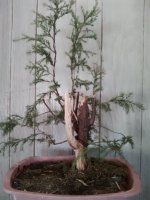Ja_De
Seedling
I NEED ANY AND ALL HELP!!!
Maryland's Eastern Shore, Temperate 7b, A bonsai beginner for over 25 years.
This one has me beat... at least it's got me scratching my head.
Common juniper, about 3 feet tall when I first saw it. Growing in a run off/ flood drain, no rain for about a month prior to city crews chopping the tree down to about 10 inches tall. A few days maybe a week later, with a spade I cut a circle with the tree as the center point, 15 inch radius, 6 inches deep.
Tree had a disk of fibrous roots 3 to 4 inches thick, 30 inches in diameter, 5-6 inches below ground. There were some roots about the size of my little finger that had to be snipped when the tree was dug up.
I perforated the bottom of a plastic dish pan. Usually I like an inch of "aquarium gravel" in the bottom of a tree container but none was available so pine mulch mixed with sand was used. I used sand from the actual site and my prime focus was to disturb the root mass as little. I didn't tease out the roots at all and the root mass held its shape for the most part and so I pretty much just "dropped" it into it's new container home. There was no cutting of any vertically oriented roots because there weren't any. I back filled the tree and watered it well assuring good root to soil contact and water quickly ran out from the bottom of the container. I thought all was good.
Days later I pruned off a few limbs and wired two limbs upwards to establish new leaders. These were about a big 1/16th in diameter and put forth hardly any resistance. This being done all there was to do was let the tree be. Some moss was laid out to help retain moisture due to the tree being planted in mostly sand. The tree was placed against the east wall of the house and received full sun from about 830am until noon. So the tree was spared of full sun during the hottest hours ( typically ) of the day.
The tree seemed to be doing well for the first few weeks. Now about 5-6 weeks after being brought home the tree looks poorly. The needles are yellowing and have lost the pokey, needle-like rigidity inherent to junipers. They are soft and pliable. There is no dropping of the foliage. The sandy soil seems be in a pot with no or very poor drainage. Today I pulled the tree up to inspect the roots. No musty, dank odor. They weren't dry as the soil was very moist. I was encouraged to find a few earth worms winding their way in the roots as I've always read that this was a good sign; indicating that the ground was not too saturated due to worms having to breathe. But still the tree seems be struggling.
Tomorrow I will repot the tree in soil with greater capability
( moreso than sand ) to drain. I was considering mixing the existing sand with pine mulch and Miracle Grow, I use MG because of its high nutrient content and I've had good results. I've considered mixing sand and coarse gritty stone and the pine bark. My gut says the tree is too wet based on the evidence of my eyes. What has rendered good results for me previously, seems in this case to be counterproductive.
Does anyone have some suggestions as to possible courses of action to remedy and save this tree? I forgot to mention that last week I poked several holes about two inches from the container bottom on the two long sides of the pot to promote drainage/aeration. I realize that the tree being chopped prior to transplanting was most likely a double whammy but it needed to be moved due what the city had planned. Ideally I'd say after being chopped by 2/3rds leaving it be until Spring was the thing to do but alas...
I know this post is lengthy but I've tried to recount what has happened with the tree accurately and completely. So thanks for having read this far. I welcome any and all ideas
that could possibly save this tree.
Maryland's Eastern Shore, Temperate 7b, A bonsai beginner for over 25 years.
This one has me beat... at least it's got me scratching my head.
Common juniper, about 3 feet tall when I first saw it. Growing in a run off/ flood drain, no rain for about a month prior to city crews chopping the tree down to about 10 inches tall. A few days maybe a week later, with a spade I cut a circle with the tree as the center point, 15 inch radius, 6 inches deep.
Tree had a disk of fibrous roots 3 to 4 inches thick, 30 inches in diameter, 5-6 inches below ground. There were some roots about the size of my little finger that had to be snipped when the tree was dug up.
I perforated the bottom of a plastic dish pan. Usually I like an inch of "aquarium gravel" in the bottom of a tree container but none was available so pine mulch mixed with sand was used. I used sand from the actual site and my prime focus was to disturb the root mass as little. I didn't tease out the roots at all and the root mass held its shape for the most part and so I pretty much just "dropped" it into it's new container home. There was no cutting of any vertically oriented roots because there weren't any. I back filled the tree and watered it well assuring good root to soil contact and water quickly ran out from the bottom of the container. I thought all was good.
Days later I pruned off a few limbs and wired two limbs upwards to establish new leaders. These were about a big 1/16th in diameter and put forth hardly any resistance. This being done all there was to do was let the tree be. Some moss was laid out to help retain moisture due to the tree being planted in mostly sand. The tree was placed against the east wall of the house and received full sun from about 830am until noon. So the tree was spared of full sun during the hottest hours ( typically ) of the day.
The tree seemed to be doing well for the first few weeks. Now about 5-6 weeks after being brought home the tree looks poorly. The needles are yellowing and have lost the pokey, needle-like rigidity inherent to junipers. They are soft and pliable. There is no dropping of the foliage. The sandy soil seems be in a pot with no or very poor drainage. Today I pulled the tree up to inspect the roots. No musty, dank odor. They weren't dry as the soil was very moist. I was encouraged to find a few earth worms winding their way in the roots as I've always read that this was a good sign; indicating that the ground was not too saturated due to worms having to breathe. But still the tree seems be struggling.
Tomorrow I will repot the tree in soil with greater capability
( moreso than sand ) to drain. I was considering mixing the existing sand with pine mulch and Miracle Grow, I use MG because of its high nutrient content and I've had good results. I've considered mixing sand and coarse gritty stone and the pine bark. My gut says the tree is too wet based on the evidence of my eyes. What has rendered good results for me previously, seems in this case to be counterproductive.
Does anyone have some suggestions as to possible courses of action to remedy and save this tree? I forgot to mention that last week I poked several holes about two inches from the container bottom on the two long sides of the pot to promote drainage/aeration. I realize that the tree being chopped prior to transplanting was most likely a double whammy but it needed to be moved due what the city had planned. Ideally I'd say after being chopped by 2/3rds leaving it be until Spring was the thing to do but alas...
I know this post is lengthy but I've tried to recount what has happened with the tree accurately and completely. So thanks for having read this far. I welcome any and all ideas
that could possibly save this tree.


